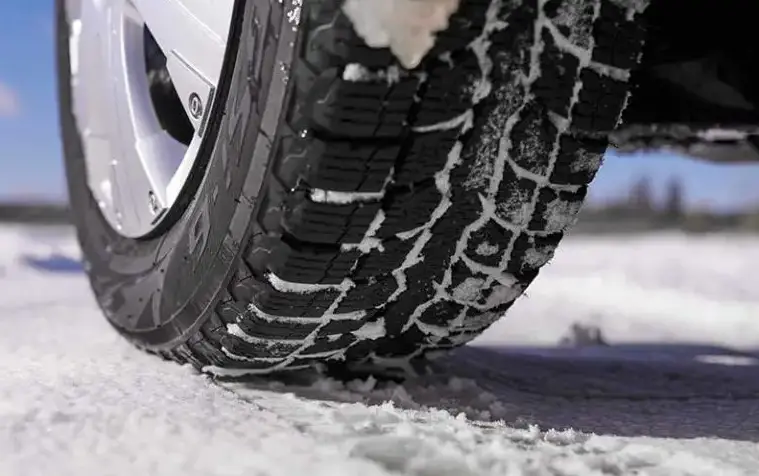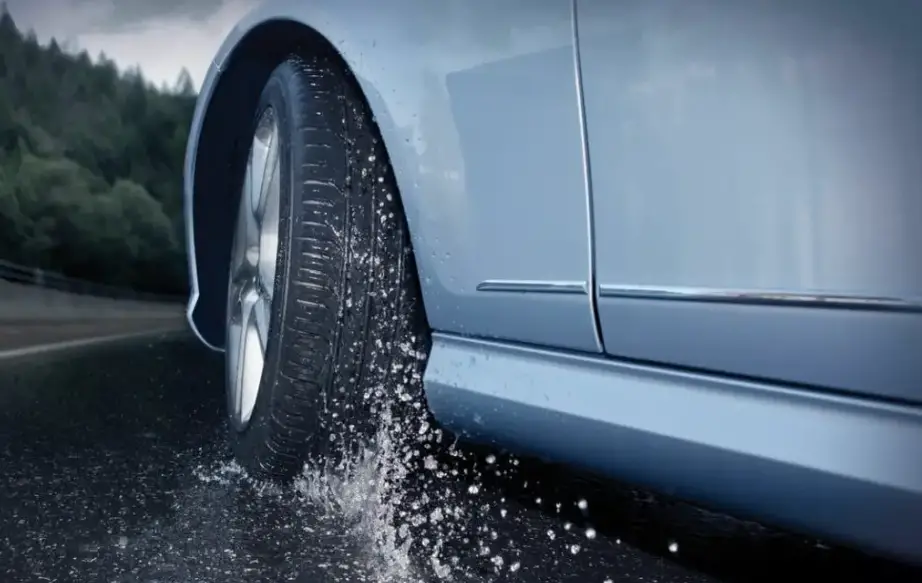Are snow tires good in the rain? Snow tires are not ideal for rainy conditions, as their soft rubber compound and deep tread patterns designed for snow can reduce traction on wet roads. While they perform well in cold, snowy conditions, they may increase the risk of hydroplaning and longer stopping distances in the rain.
When it comes to driving in different weather conditions, tire selection plays a crucial role in ensuring your safety and vehicle performance. Snow tires, or winter tires, are designed to provide optimal traction and handling in icy, snowy, and frigid conditions. But what happens when the snow melts and rain takes over? Are snow tires still effective when the weather is wet, or do they fall short of expectations?
In this article, we will explain how snow tires perform in rainy conditions. While snow tires are essential for cold-weather driving, their softer rubber compound and deeper tread patterns may not be ideal for wet roads.

Contents
What Are Snow Tires?
Snow tires, also known as winter tires, are designed specifically for driving on snow, ice, and in extremely cold conditions. The key differences between snow tires and other types of tires are their tread patterns, rubber compounds, and ability to maintain traction in freezing temperatures.
Key Features of Snow Tires:
- Softer Rubber Compound: Snow tires are made with a rubber compound that remains flexible at low temperatures. This flexibility provides better traction on cold, icy, or snowy surfaces.
- Deeper Tread Patterns: The tread design of snow tires is much deeper than that of all-season or summer tires. The deeper grooves and voids help to channel snow, slush, and water away from the tire, increasing traction.
- More Sipes: Snow tires have numerous sipes (small slits in the tread) that create extra biting edges, improving traction on snow and ice.
Snow Tires in the Rain: How Do They Perform?
Snow tires are designed to provide exceptional traction in snowy and icy conditions, but how do they perform in rainy weather? While snow tires are highly effective in cold and wet snow, their performance on wet asphalt can be less reliable due to their soft rubber compound and tread design, which is optimized for snow, not rain.
1. Rubber Compound and Performance in Wet Weather
The rubber used in snow tires is much softer than that in all-season or summer tires, which is ideal for cold temperatures. However, this softness can cause problems when temperatures rise or when driving in wet conditions.
How Snow Tires Perform in the Rain:
- Less Grip on Wet Roads: In warm or rainy weather, the soft rubber compound of snow tires can become too soft, which means it doesn’t grip the road as effectively as other tires designed for wet conditions.
- Increased Wear: Snow tires are designed to wear down slower in cold weather. However, in warmer temperatures or during rain, the softer compound wears down more quickly, reducing the tire’s lifespan.
- Hydroplaning Risk: Since snow tires have deep grooves and are designed to channel snow and slush, they are not as effective in shedding water from the road in the same way that all-season or rain tires are. This can increase the risk of hydroplaning, where the tire loses contact with the road due to a layer of water, especially at higher speeds or during heavy rain.
In short, snow tires are not ideal for rainy conditions because they can wear faster and have reduced grip on wet roads.
2. Tread Design: Snow Tires vs. All-Season Tires in the Rain
The tread design of snow tires is another important factor to consider. Snow tires feature deeper grooves and more pronounced lugs, designed to dig into snow and slush. While this is beneficial for winter driving, it is not optimal for wet roads.
Performance in Wet Conditions:
- Water Evacuation: The deep and aggressive tread of snow tires may not efficiently channel rainwater away from the tire as well as all-season tires. This can cause less effective traction and increased risk of hydroplaning on wet roads.
- Comparison to All-Season Tires: All-season tires are designed to perform well in both dry and wet conditions. Their tread patterns are optimized to handle rain by channeling water away from the tire more effectively. Compared to snow tires, all-season tires generally offer better grip and shorter stopping distances on wet roads.
3. Traction and Braking Performance
Snow tires are built to provide exceptional traction on snowy, icy, and slushy surfaces. However, this doesn’t always translate to better performance on wet roads. The increased flexibility of snow tire rubber in cold weather can actually become a disadvantage in rainy weather.
What Happens During Rain:
- Decreased Traction: Snow tires struggle to maintain the same level of traction in the rain as they do on snow and ice. The softer rubber and aggressive tread that work well in snow can make the tire feel “squishy” or unstable on wet, slick asphalt.
- Longer Stopping Distances: Due to the reduced grip in the rain, snow tires tend to have longer braking distances on wet roads compared to all-season tires, which are specifically designed to offer better stopping power on wet surfaces.

When Are Snow Tires Suitable for Rain?
Snow tires are specifically designed to excel in cold, snowy, and icy conditions. However, they may not always perform optimally in rainy weather. Understanding when snow tires can still provide adequate traction in the rain is crucial for ensuring safety while driving in variable conditions.
1. Cold Rain
In cold rain (when the temperature is below 45°F or 7°C), snow tires may still perform adequately. Snow tires are designed to handle cold conditions, and the rainwater in such conditions is less likely to affect the tire’s performance negatively. However, even in these conditions, snow tires are still not as effective as all-season or rain tires, which are specifically designed to handle wet surfaces.
2. When Transitioning from Snow to Rain
In areas where snow transitions to rain, snow tires can still offer some level of traction, especially if the ground is still cold, and snow is present. Snow tires perform well in light rain when temperatures are still low enough to keep the tire compound soft and grippy.
3. Light Rain Conditions
In light rain, snow tires may provide a certain level of grip, but they are not optimized for water evacuation or wet traction. Snow tires can work in mild rainy conditions, but they are not the best option for consistent wet-weather driving.
Alternatives to Snow Tires for Rainy Conditions
If you live in an area with frequent rainy conditions, it is recommended to switch to tires better suited for wet roads. Here are some alternatives:
1. All-Season Tires
All-season tires are a great alternative when transitioning from winter to rainy conditions. These tires are designed to perform well in a variety of conditions, including light snow, wet roads, and dry conditions. Their tread patterns are optimized for water evacuation, providing better traction and handling on rainy roads compared to snow tires.
2. Rain Tires
Rain tires or tires designed for wet conditions have specialized tread patterns that are specifically designed to perform in heavy rain. These tires provide superior water displacement and traction on wet roads, significantly reducing the risk of hydroplaning.
3. Summer Tires
Summer tires are engineered to provide excellent traction in both wet and dry conditions but are not suitable for winter weather. They perform particularly well in the rain because of their tread design and harder rubber compound that allows for better water evacuation.
Frequently Asked Questions
Here are some FAQs about snow tires in the rain –
1. Can snow tires be used in the rain?
Yes, but snow tires are not optimized for rain, and their performance on wet roads can be subpar compared to all-season or rain tires. They may cause longer stopping distances and increase the risk of hydroplaning.
2. Do snow tires wear out faster in the rain?
Yes, snow tires tend to wear out faster in the rain, especially in warmer temperatures, because the softer rubber compound is not designed for wet roads.
3. Are all-season tires better than snow tires in the rain?
Yes, all-season tires are better suited for wet conditions as their tread patterns and rubber compounds are designed to efficiently channel water away from the tire, providing better traction and braking in the rain.
4. Can I use snow tires year-round?
It is not recommended to use snow tires year-round. Using them in warmer temperatures can lead to faster wear and reduced performance in dry and wet conditions.
5. Should I switch to rain tires during the rainy season?
If you live in an area with frequent heavy rain, it’s a good idea to use rain-specific tires for the best wet-weather performance. However, all-season tires are also a good alternative for rainy conditions.
Conclusion
While snow tires are excellent for snow, ice, and cold weather, they are not ideal for rainy conditions. The soft rubber compound that helps them grip snow and ice can cause reduced performance on wet roads, including longer stopping distances, less traction, and an increased risk of hydroplaning. Snow tires are best suited for cold, snowy, or icy conditions, and for safety reasons, it’s better to switch to all-season or rain-specific tires during the rainy season.